
Project
Effects of climate and habitat heterogeneity on the olive fruit fly and its natural enemies
The olive fruit fly is the main pest in olive agroecosystem and can cause severe damage to olive production. Up to date, the control of this pest is mainly based on the application of synthetic pesticides that lead to olive fruit fly resistance, environmental degradation and can be harmful for the non-target organisms. Hence, a more environmentally friendly method to control this harmful pest is of great importance. In this project, I investigate the interactions between olive, olive fruit fly and the parasitoids of the olive fruit fly as well as the genetic structure and diversity of this pest in order to improve the efficiency of the olive fly parasitoids as biocontrol agents and thus to optimize the control of the olive fruit fly.
The olive fruit fly is a major threat in olive production and can cause severe damage to olive fruits resulting to high yield losses and degradation of the quality of the olive products. Up to date, the control of this pest is mainly based on the application of synthetic pesticides that lead to olive fruit fly resistance, environmental degradation and can be harmful for the non-target organisms. Hence, a more environmentally friendly method to control this harmful pest is of great importance. Parasitoid wasps are often used as biological control agents in agriculture and horticulture to suppress insect pests. By investigating the interactions between the olive, the olive fruit fly and its parasitoids in different spatial and temporal scales will help to understand how spatial heterogeneity and abiotic factors affect these interactions. Moreover, knowledge on the foraging behavior of the parasitoids of the olive fruit fly and the chemical cues involved in therein as well as on the population structure and the genetic diversity of the olive fruit fly is essential in order to improve the biological control of the olive fruit fly, to develop adequate pest management strategies, and thus to minimize insecticide applications.
Project description
The main aim of this project is to improve the biological control of the olive fruit fly, Bactrocera oleae (Diptera: Tephritidae). To achieve this aim, the project is focused to understand/unravel: a) the effect of the climate variation, habitat heterogeneity and management system on the olive fruit fly density, fruit damage levels, parasitism rates and on natural enemies abundance and diversity, b) the effect of different agroecological zones (ecotypes – climatic variation) and contrasting biodiversity levels and pesticide applications (conventional systems vs organic/biodiversity-based systems) on the genetic structure, diversity, gene flow and migration patterns of the B. oleae among different locations, and c) the role of olfactory cues emitted from the plant-host complex (herbivore-induced plant volatiles, i.e., plant synomones) upon infestation by the olive fruit fly and from the herbivore itself (pheromones, i.e., host kairomones) during host location of the parasitoid wasps of the olive fruit fly. A better understanding of the host location behavior of parasitoids is needed in order to improve their efficiency as biocontrol agents. Knowledge will be gained from this research may help in the application of appropriate pest control strategies to improve the control of the olive fruit fly by natural enemies.
Publications
- Bogka G., Volakakis, N., Kollaros, D., Pannebakker B.A., Fatouros, N. and Kabourakis, E., 2022. Comparing olive fruit fly (Bactrocera oleae) density, fruit damage levels and parasitism rates in organic and conventional olive orchards in Crete, Greece. IOBC-WPRS Bulletin Vol. 158, pp. 7-11. Edited by: Ana Cristina Ramos, José Alberto Pereira, Paula Baptista. ISBN 978-92-9067-344-6 [XVIII + 113 pp.].